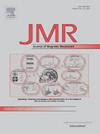Diffusion coefficient measurements for moving samples under strong magnetic field gradients
IF 1.9
3区 化学
Q3 BIOCHEMICAL RESEARCH METHODS
引用次数: 0
Abstract
Among the numerous measurements carried out during a well-logging procedure, the Nuclear Magnetic Resonance (NMR) assessment is one of the fundamental analyses in determining the economic viability of a well for the oil industry. Nowadays, two reliable approaches, Wireline Logging (WL) and Logging While Drilling (LWD), stand out. WL comprises the acquisition of NMR data under static conditions. On the other hand, in LWD, the NMR measurements happen simultaneously with the drilling process, while the NMR tool experiences translation, rotation, and vibration motions relative to the rock formation. In order to comprehend better the NMR response acquired under LWD conditions, a setup emulating an LWD tool was developed, consisting of a single-sided magnet, rf probes, and a mechanical device that emulates a relative sinusoidal movement between the sample and the applied magnetic field. A bulk sample and three representative rocks, Fontainebleau Sandstone, Berea Sandstone, and Indiana Limestone, were investigated. Even though the diffusion coefficient measurements remain neglected for their intrinsic characteristics of data acquisition, the findings demonstrate that the diffusion coefficient parameter of a fluid in a bulk sample or confined in a porous rock can be precise and accurately predicted. In strong magnetic field gradients, the Hahn spin echo is predominantly weighted by the diffusion process, an effect used to measure diffusion coefficients. Under LWD conditions, the diffusion coefficient measurement is considerably affected by signal phase modulation due to sample movement in the presence of strong magnetic field gradients, making this measurement difficult. This article present solutions for correct diffusion coefficient measurements, synchronizing Hahn spin echo experiments with sample movement.

强磁场梯度下移动样品的扩散系数测量。
在测井过程中进行的众多测量中,核磁共振(NMR)评估是确定石油工业油井经济可行性的基本分析之一。目前,有两种可靠的方法,即电缆测井(WL)和随钻测井(LWD),脱颖而出。WL包括静态条件下核磁共振数据的采集。另一方面,在随钻测井中,核磁共振测量与钻井过程同时进行,而核磁共振工具相对于岩层经历平移、旋转和振动运动。为了更好地理解随钻条件下获得的核磁共振响应,开发了一个模拟随钻工具的装置,该装置由单面磁铁、射频探头和一个模拟样品与外加磁场之间相对正弦运动的机械装置组成。研究了大量样品和三种代表性岩石,枫丹白露砂岩、伯里亚砂岩和印第安纳石灰岩。尽管扩散系数测量由于其数据采集的固有特性而被忽略,但研究结果表明,在散装样品中或在多孔岩石中限制的流体的扩散系数参数可以精确和准确地预测。在强磁场梯度中,哈恩自旋回波主要由扩散过程加权,这是一种用于测量扩散系数的效应。在随钻条件下,在强磁场梯度存在的情况下,试样移动引起的信号相位调制对扩散系数的测量有很大影响,使测量变得困难。本文提出了正确测量扩散系数、同步哈恩自旋回波实验和样品运动的解决方案。
本文章由计算机程序翻译,如有差异,请以英文原文为准。
求助全文
约1分钟内获得全文
求助全文
来源期刊
CiteScore
3.80
自引率
13.60%
发文量
150
审稿时长
69 days
期刊介绍:
The Journal of Magnetic Resonance presents original technical and scientific papers in all aspects of magnetic resonance, including nuclear magnetic resonance spectroscopy (NMR) of solids and liquids, electron spin/paramagnetic resonance (EPR), in vivo magnetic resonance imaging (MRI) and spectroscopy (MRS), nuclear quadrupole resonance (NQR) and magnetic resonance phenomena at nearly zero fields or in combination with optics. The Journal''s main aims include deepening the physical principles underlying all these spectroscopies, publishing significant theoretical and experimental results leading to spectral and spatial progress in these areas, and opening new MR-based applications in chemistry, biology and medicine. The Journal also seeks descriptions of novel apparatuses, new experimental protocols, and new procedures of data analysis and interpretation - including computational and quantum-mechanical methods - capable of advancing MR spectroscopy and imaging.

 求助内容:
求助内容: 应助结果提醒方式:
应助结果提醒方式:


